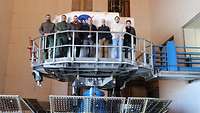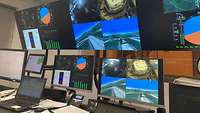Helicopter simulation - a visit to NASA
AIN-News- Date:
- Reading time:
- 2 MIN


From 27 February to 03 March 2023, two test pilots and one engineer of the Bundeswehr Technical Centre for Aircraft and Aeronautical Equipment (WTDWehrtechnische Dienststelle 61) from Manching visited the American National Aeronautics and Space Administration (NASA) in Moffet Field, California, USA.

From left to right: two test pilots and one WTDWehrtechnische Dienststelle 61 engineer with the NASA project team in front of the simulation cabin
NASAThe visit to NASA’s Ames Research Center took place within the scope of the German-American research cooperation "Project Agreement Advanced Rotorcraft Technologies" (PA ATRProject Agreement Advanced Rotorcraft Technologies). One objective of the cooperation is the further development and adaptation of evaluation processes for the flight characteristics of new helicopter configurations.
The flight data from the different configurations collected in the flight simulator, the "Vertical Motion Simulator", with the world's most powerful motion system are the basis for the prototypes of new helicopter generations. One of the two test pilots said: "The simulator can simulate all flight characteristics that I specify for it through the software". Thus, the effectiveness of flight control systems can be assessed. According to the test pilot, it is also relatively easy to switch cockpits in order to emulate the feeling of the respective helicopter in the simulator.
During the tests, the simulation cabin moves up to 12.2 meters (40 feet) horizontally and up to 18.3 meters (60 feet) vertically, depending on the configuration.
The two WTDWehrtechnische Dienststelle 61 pilots tested three possible future high-speed configurations in a generic cockpit:
First, a helicopter with tilt rotors was flown. When the rotors are tilted forward, it flies like an airplane. When they are tilted upwards, it flies like a helicopter. Next up was a configuration with a coaxial rotor. The two main rotors are arranged on top of each other on one rotary axis and rotate in opposite directions - meaning that the traditional tail rotor is no longer needed. Instead, this configuration has a thrust propeller at the rear, which provides forward propulsion and can also be used to brake. The third variant has very long stubby side wings, which generate additional lift in forward flight and thus relieve the rotor.

Several screens next to and on top of each other form one large screen
Bundeswehr/Alexander HöhnDuring the numerous flight simulations conducted, the two WTDWehrtechnische Dienststelle 61 pilots had the opportunity to extensively test and evaluate the flight characteristics. The WTDWehrtechnische Dienststelle 61 engineer responsible for the "PA ATRProject Agreement Advanced Rotorcraft Technologies" project also used the visit for a lively exchange with the pilots and engineers of other nations who were also involved.
For example, the WTDWehrtechnische Dienststelle 61 team will bring back home new findings on the flight behavior and control concepts of new helicopter generations: compared to current helicopters, they permit a maximum flight speed that is twice as high, which is now an essential requirement for new generations of helicopters.